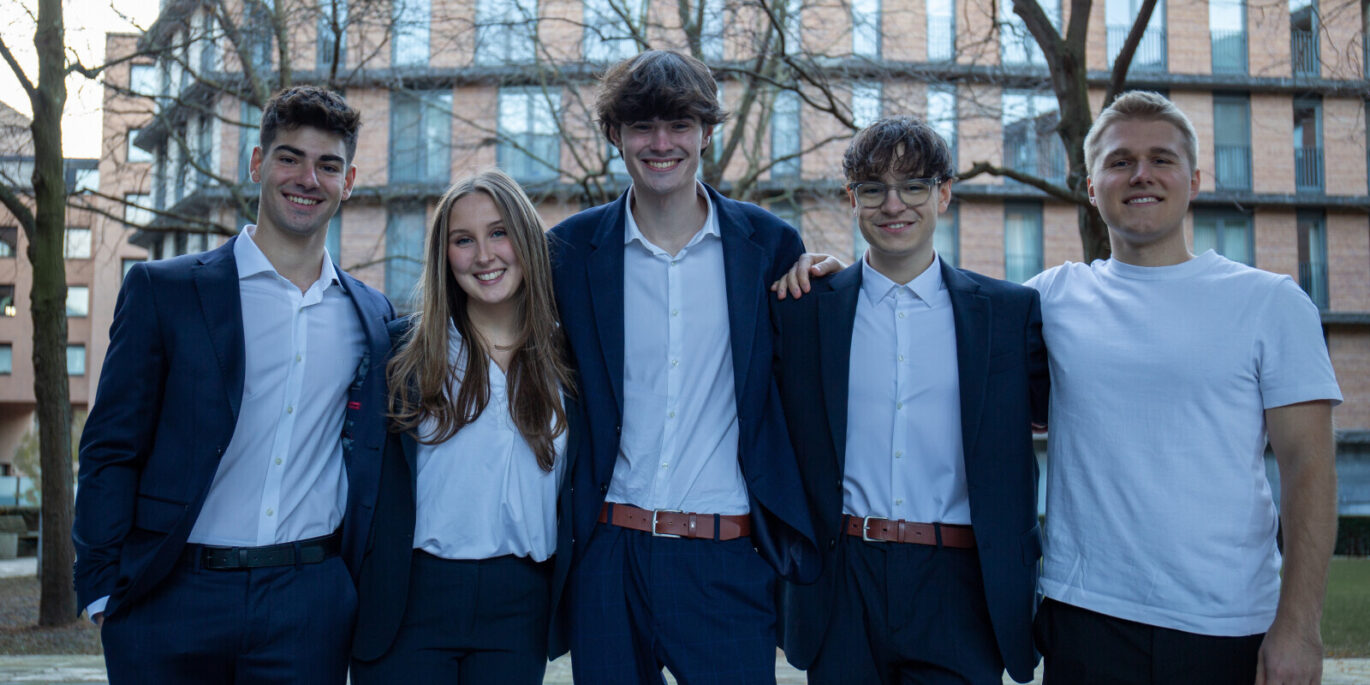Back in 2024 when I working at Westminster SU, I was part of a group of SU officers and staff that embarked on a week long study tour through the Baltics and Finland.
Starting in Riga, Latvia and ending in Helsinki, Finland, we visited SUs across the Baltics to learn from our European counterparts and explore how they approach student representation, democracy and services.
National pride – reflections on a nation’s history
It took no time at all for us to be introduced to strong patriotic traditions driving through much of student culture in the Baltics. Whilst at Latvia University, we met with the sorority “Dzintra”, who will be celebrating their centenary in May. They shared their values – love for their country, honour and friendship – with aims to bring together women across generations to strengthen friendship and interest in Latvian history and culture.
Across the border in Tartu, we spent an evening hosted by the fraternity ‘Korp! Revelia’. Founded in 1920 after the Estonian War of Independence, they’re an exclusive association of patriotic Estonian men who come together and build bonds over Estonian principles. Like the sororities, they’re cross-generational, meaning that new recruits have access to senior Estonian decision-makers, like the government’s Minister of Defence.
I think it’s fair to say we all left the frat house quite speechless, relieved that fraternity culture doesn’t exist in the UK. But one major question I’ve since reflected on is this – what differences in Latvian and Estonian history have caused their senses of patriotism and nationalism to feel so distinct from British patriotism? You could sense their patriotism is distinct from that I’ve seen in England.
The answer is quite simple, I think. Being a British nationalist necessarily brings into frame coloniality and imperialism. Being proud of British history includes the celebration of the British Empire. However, only recently have both Latvia and Estonia gained their independence. Occupied throughout much of the 20th century, what I think their patriotism refers to is the celebration of this independence from firstly the Soviet Union – the celebration to the end of occupation and tyranny.
These differences are felt in student spaces, and I wanted to share it to highlight that some lot of what we experienced across the week is necessarily set in conditions that we cannot replicate back home. I’ll leave this section with one quote that has stuck with me:
“If we don’t celebrate the nation of Estonia, what’s the point? We may as well be added back in to another country.”
Foster community building first
A core theme we discovered throughout Finland was the quite simple idea that students should be empowered to act on their own accord, to go and discover challenges by themselves and be able to make mistakes. Now, this might be because most SUs we visited do not possess the staff resources most SUs in the UK have – Abo and Arcada are both entirely student led, Tampere and Hameenlinna both only have one permanent staff member and Haaga-Helia have four members of permanent staff.
The explicit focus on solely student-led activities did strike a chord, however. Institutions, whether by design or necessity, allow students to crack on. I’m sure we’ve all experienced the challenges of installing microwaves or hot water taps for student use and the risk mitigation measures in place for student events. In Latvia, Estonia and in Finland, we saw very little risk assessment mentality.
And, in many instances, this does keep many students engaged. However – and we didn’t quite have enough time to properly scrutinise this – I do wonder how many students it keeps out of the events community loop. But, this is for sure – the student commercial kitchens we visited that are regularly used by students are kept in good working order with no staff oversight.
Overalls, sewing socials and communal identity
Communitarianism is a philosophy built on the idea that we look for, and spend most of our time in, socially-constructed communities. It suggests that our moral judgements and social values are informed by the collective groups with whom we identify. Communitarian advocates and practitioners often emphasise the values of communal and public goods and commodities.
We did not need to look far to see communitarianism in practice, especially in Finland. Tampere SU were very excited to share with us their public sauna, which fosters healthy community and discourse, and we ate at multiple university canteens – places that people can come together over a shared desire and foster these communities. They’re the backbone of many university experiences. This is probably helped as well by the Finnish government student meal subsidies – every student is entitled to a healthy canteen meal, for just 2.95 euros.
One example of communitarianism we perhaps did not expect to see in such rich abundance was Finland’s overalls culture. Developed out of Sweden in the 1970s, SUs sell hundreds of overalls, or boiler suits, to students each year. Students do love collecting things – whether that be sports or societies stash, photo booth snaps or free things at Welcome Fayre. Students then wear their overalls – which are often in the colour of their academic department – at social events, around campus and wherever else they want to highlight they’re part of the university community.
During their time at university, students can also earn or buy badges which reflect their interests, the events they’ve attended and groups they’re a part of. Students revel in the badge collection mentality, which we quickly bought into when given the opportunity at Haaga-Helia, and are very proud of the identity they can present through this uniform. At Arcada, we heard about sewing socials – opportunities where students just get together to socialise, typically watching TV, whilst cooking dinner or listening to music, whilst sewing their newly-collected badges on their overalls. It was quite amusing when, trying to leave Haaga-Helia to visit a student culinary kitchen, we stumbled on an array of student stalls – not dissimilar from Welcome Fayre – selling badges and recruiting members to their respective associations. On a random Thursday morning.
Academic credits for volunteering
With so few permanent staff and not much money to go around, the SUs we met have come up with innovative methods to promote volunteerism and ensure engagement is maintained by providing genuine benefits. For example, many universities we met provide study credits for students completing volunteer, advocacy and representation roles. They provide up to 15 credits, equivalent of one full module, for the following activities.
- Social activity 1 – role of a member of an association or SU, maximum five credits. Must write about the basics of SUs and understand political responsibility and targets of influence.
- Social activity 2 – association leader or Student Representation Council member, maximum five credits. Must write about their experience in a leadership role and highlight how they manage the weight of trust, manage interest groups and project manage.
- Social activity 3 – SU board member or trustee in national student organisation, maximum five credits. Must show understanding of national issues and how to engage effectively with these.
The University of Helsinki were especially proud of this system, arguing that rewarding student volunteerism improves engagement, builds more-rounded, knowledgeable graduates and, above all else, is just the right thing to do. It feels like a win-win, as one credit is equivalent to about 27 hours of volunteer work. So, only the most invested students feel the benefit – which they argue is no bad thing.
One of the most similar examples of this applied in the UK is at Manchester Met, where their volunteering RISE programme allows some students, not all programmes are eligible, to claim points from volunteer work in exchange for academic credits. However, these credits are only applied if a student has one below average module – so it serves as an insurance incentive.
SU advocacy in the city
We heard from many SUs about how their democratic governance structures are set up, and there was quite a lot of similarities in each nation. However, one key question we sought to get answers to was ‘why is your democratic governance structured in this particular way’? Why do you provide advocacy support in the way you do? Is it because that’s the way it’s always been done? Or, is there some deeper reason which is that it empowers and supports more students to engage and have that sense of community belonging we’re constantly striving to help build?
Importance of advocacy support
At Aalto, on the outskirts of Helsinki – who claim to provide the best student experience in the world – they answered the “why advocacy” question quite explicitly.
- Tricky situations – life doesn’t always fit in neat boxes. Their advocacy service is flexible in supporting students identify and define issues, then provide support to ensure student issues are fairly represented to the university.
- Rights – students are not always aware of their own rights and those of others. They focus on education and guidance, communicating about rights and responsibilities, to help students stand up for their own rights.
- Reaction to crises – occasionally, a crisis arises in the community. The SU uses their position to vocalise student issues in cooperation with the local community.
Just one policy paper
Many SUs we met with have simplified their policy and advocacy guidance into a singular paper. Covering all student themes which are political in nature, Representative Councils are responsible for drafting, approving and amending the SU’s Policy Paper. They serve as the foundation of the SU’s advocacy work, are updated when the need arises and are in effect indefinitely. For example, within HYY’s 34-page paper, they demand the following.
- The University adheres to the UN’s Principles for Responsible Investment in its investments.
- Teaching material is genuinely free, and university libraries must have enough course material available.
- Student discounts in public transport are at least 50 per cent of ticket prices and cover doctoral students and students over 30 years of age, too.
Elsewhere in Helsinki, Haaga-Helia introduced us to the World Student Capital project. They work with other Helsinki SUs, HOAS and sector experts with the objective of making citywide statements on behalf of 100,000 students. Research and insight is then used as a key resource in lobbying efforts.
Course elders and representation
At Tallinn, student academic reps, or Course Elders, are responsible for bringing proposals to their respective departmental Student Council. There are six departments, each with their own Student Council, who meet every month to discuss proposals. Course Elders also use this mechanism as an events organising space – really bringing community and events to their decision-making spaces.
One major difference is that students elect members of Student Councils via cross-campus ballot. Course Elders are then responsible for appointing the student executive board, who are the equivalent to our Sabbatical Officer team. This means the most senior student representatives are not directly elected by the entire student population.
At Aalto, who have a similar electoral system, we got to ask if the lack of electoral opportunity for student board causes any challenges. I think their figures at the last Representative Council election suggests it’s highly beneficial for engagement. Using a list system – students group together into political parties, so students only cast one vote for whichever party, rather than individual, they wish – votes and seats are distributed proportionally. If Political Party A receive 20 per cent of votes, they will be provided 20 per cent of Council positions. In their 2023 election, they achieved a voter turnout of 32 per cent and had 236 candidates.
These are remarkable numbers, and my assumption is the power to be able to appoint the executive board contributes to students’ wishes to get elected to, and attend, Representative Council.
Now could we, if we wanted, apply this system? Legally, yes we probably could whilst maintaining compliance with the 1994 Education Act. Now, would we want to? That’s a totally different question.
Student participation in committees
Across UK universities, it’s apparent that too few student reps, often the President or wider sabbatical officer team, are invited to too many committees. In Latvia, they’re able to include many more students within university committee systems. This is helped by parliamentary legislation – 20 per cent of university committee membership must be students, students hold veto rights and one two-hundredth of every HEI budget must go to the local SU.
We were also able to hear from a university strategy team on how they try to continually foster active student engagement in their decision-making bodies. The University of Helsinki have just completed a review with their SU, HYY, on how to increase student participation at committee levels. Their recommendations included the following.
- Develop student engagement strategies at faculty, rather than programme, level
- Develop student representative recruitment in partnership with the SU.
- Each faculty should provide its student representatives with orientation, in partnership with the SU.
- Develop steering group work based on student needs, such as attending a steering group meeting will be considered an acceptable reason for class absence, steering group to produce newsletters on topics discussed in meetings for circulation to all students and EDI to be prioritised in all steering group activities.
(Inter)national lobbying efforts
Unfortunately, not everything is totally rosy in Baltic SUs. In Finland, there are two types of universities, where they legally differentiate a University and a University for Applied Sciences, or UAS. Independent SUs are enshrined in both, but with different membership and funding mechanisms.
- Universities – every student is a member of their SU, with no option to opt-out. They must all pay the enforced subscription fee, typically 50 to 125 euros per year.
- UAS institutions – students choose to become a member by paying a subscription fee. At HAMKO, who have approximately 50 per cent of students signed up as members, this is 75 euros per year and includes a pair of overalls.
Last year, Finland elected a new government, formed from a coalition of two of the most right-wing parties. The implications felt at SU level was almost palpable. Especially in university, rather than UAS, SUs, there’s a certain fear that their membership model will be changed. HYY – the richest SU in the world due to owning a 425.9 million euro real estate company, yes seriously – are working hard to ensure the SU can still function if they are moved to a UAS-style membership model. Meanwhile, lobbying at a national level is being orchestrated by the Finnish NUS.
This did raise some questions for those of us on the trip. In particular, if the UK government went one step further from existing law, changing SU membership from opt-out to opt-in, how would we ensure that a high number of students are still interested in being a member? And how would we continue delivering services if, overnight, we couldn’t be funded in any part by the university? Would we look to implement a subscription model which students pay into in exchange for our services?
Alumni relations
One key mechanism local SU exec boards are utilising is their alumni connections. At Abo, for example, we met their chairsperson, who quite openly stated that she’s not too worried about legislative change because she has an MP – an Abo alumni – on speed dial. Apparently, this is the case for many student reps.
In Finland, there is a benefit that there are just 14 universities, which increases the likelihood of a former student holding some form of legislative power. This sense of close proximity to parliamentary decision-makers was similar in Tallinn, where the students we met were very proud of the successful protests they’d held outside the Estonian Prime Minister’s house. Kaja Kallas, the Estonian PM, was a student at Tartu in 1999 and spent a great deal of time working with all Estonian SUs whilst she was a student. I don’t think the same can be said here in the UK.
Bringing it back to community – student support
In Finland, every SU of a University for Applied Science, or UAS, spoke passionately about their student mentoring programmes. UAS SUs are not guaranteed student membership and funding. At HAMKO, they have a couple of key strategies which ensure students choose to register – mentoring and student cards. Mentoring was a prominent point of discussion at every Finnish SU we met. Launched at the start of each academic year, peer tutors, or returning students, and alumni mentors are hired and trained to support anywhere between five and 15 students.
Peer tutors are hired to help new students get to know each other, discover their new environment and learn local traditions. Haaga-Helia’s tutor training consists of understanding the university, EDI and different approaches and methods in engaging with a diverse range of students.
Alumni mentors, or elder professionals, are there to open doors, provide contacts and give students ideas in transitioning to their chosen career. Similarly, Aalto’s mentoring programme is tied in closely with its alumni work and facilitated career design.
HAMKO also provide student cards for those who pay membership. For the most part, this is a standard student card which offers discounts and other benefits like that in the UK. HAMKO predicts 90 per cent of its paying members keep paying the membership because of this student card. This is perhaps because, with no alternative student university card available, if you haven’t join the SU, you cannot get into university buildings – like the library – outside of normal hours. Wild.
Student housing
In Estonia, we met with their National Union of Students, or EUL, who stated that student accommodation has slightly improved following new national regulations. However, student rent is still high. The housing crisis message was reiterated when representatives from Tallinn University SU spoke.
Across the border in Tampere, we learnt that the SU holds agreements with the city regarding transport, housing and the student experience.
In Helsinki, we met with HOAS, a foundation for affordable student housing. A non-profit providing housing for 1,800 students within the Helsinki region, their properties are at least 35 per cent cheaper than market prices. Every student in a HOAS property can expect to pay between 250 and 400 euros per month. Water, electricity, internet, laundry and saunas are provided in the rent.
But how? HOAS works closely with the Housing, Finance and Development Centre of Finland, or ARA, who belong to the Ministry of Environment and are responsible for the implementation of Finnish housing policy.
In preparation for last year’s parliamentary election, UAS SUs in the Helsinki region produced an urban policy programme as a tool for student campaigners to lobby for specified, impactful improvement at municipal level. Across four themes – housing and zoning, services, transportation and participation – the working group identified a range of goals, including the following.
- Solutions need to be found for student homelessness and hidden homelessness, such as increasing low-cost mini-housing and developing an urgency system.
- Prevention of sexually transmitted diseases and pregnancy must be free of charge for under-29s and all university students. They must receive genuinely free contraception with no time limit. You must be able to choose the type of contraception yourself.
- The public student discount must be at least 50 per cent on all transportation ticket types.
- All college campuses must have a polling station.
Going home
This tour was great. The opportunity to build links with our European counterparts, to see how they approach the same challenges we face in the UK and to spend concentrated time with colleagues from other SUs was invaluable.
There’s something particularly powerful about bringing together officers and managers on a trip like this – the mix of perspectives, the informal conversations over meals and travel and the shared experience of being slightly outside our comfort zones creates space for honest reflection that’s hard to replicate at conferences or in our day-to-day work.
But perhaps the most important thing to say is this – study tours like these aren’t about finding a perfect model to copy and paste back home. The contexts are too different, the histories too distinct and the legislative frameworks too varied for that to make sense.
Instead, what trips like this offer is something more valuable – they make you think. They challenge assumptions about how things have to be done, they spark questions about why we do things the way we do and they remind us that there are always different ways to approach the work of supporting students and building community. And that, ultimately, is what makes the journey worthwhile.


















